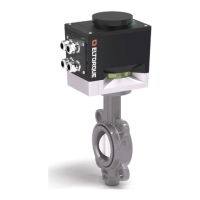Product Description
Page 30 of 62 User Manual QT50 Doc ID 1321 version 2.0 Sept. 2018
Figure 13: QT 50 Settings for closed position
Torque considerations for valve and actuator
The actuator must have sufficient torque to operate the valve in all situations
with an acceptable safety margin. Valve type, temperature, operating pressure,
medium density and viscosity and the medium’s effect on the valve friction are
among the variables that need to be evaluated. A change in any of these
variables may change the required operating torque. Preferable a torque table
with all parameters should be used, but for an electrical actuator, the output
torque is constant, reducing the considerations to be made. Using the break to
open (BTO) value usually gives a correctly sized actuator. The break to open
torque is defined as the torque required to move the valve out of the seat.
Be aware that the MAST of the valve needs to be verified to prevent damage to
the stem. Eltorque can assist with the necessary experience in selecting the
correct size of the actuators for the valve.
Closing time
For the QT50 the closing time is configurable within a predesigned interval. The
opening and closing profiles are shown in Table 5: System performance
parameters for QT50 actuators on page 17.
For the QT50, the closing time is configurable within a predesigned interval.
Hence, the opening/closing profile can be optimized to fit most system
specifications.
Configuration
The actuator is configured from a computer and it is delivered with the
configuration specified by the customer. Eltorque provides the E3C
configuration software which runs on a standard PC and the corresponding User
Manual E3C Software.
The software can be downloaded from the Eltorque website www.eltorque.no –
Technical Support – Software.
The Eltorque Configuration Cable is needed to connect the actuator to the
configuration PC/PLC. It must be ordered separately, see Chapter 8 Ordering
Information and Recommended Spare Parts on page 55.

